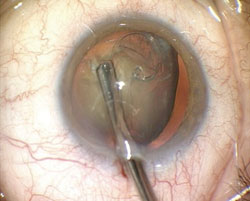Modified endocapsular ring allows for capsular bag stabilization during MICS
A modified Malyugin-Cionni ring makes IOL implantation easy and safe in case of profound zonular weakness, zonulolysis or other problems that require stabilization of the bag during microincision cataract surgery, a surgeon said.
“There are cases of severe zonule dialysis, due to systemic or ocular diseases as well as ocular trauma, in which iris hooks or regular tension rings are not sufficient to achieve capsular bag stability. When we have to deal with weakened and loose zonules leading to lens subluxation and phacodonesis, we need special rings that can be sutured to the sclera. Only then will we be able to carry out safe phacoemulsification with IOL implantation,” Boris Malyugin, MD, said at the meeting of the French Society of Ophthalmology in Paris.
The Malyugin-Cionni endocapsular ring (Morcher) works well in these complicated cases. It is a flexible PMMA filament with eyelets at the two ends. Joined to the ring is an additional PMMA fixation element, a hook with a third eyelet that is used to fixate the ring to the sclera.
“This and other devices — Ahmed capsular tension segment, Assia anchor, etc. — have allowed us to perform cataract surgery in extremely complicated cases. However, in the era of MICS, we need the instruments with the new design allowing them to be introduced onto the eye through microincisions. The Cionni ring, due to the presence of a fixation hook, cannot be easily loaded in and implanted through an injector,” Dr. Malyugin said.
|
Image: Malyugin B |
In his modification of the Cionni ring, the shorter segment is cut off at the point of insertion of the fixation hook. The result is an asymmetric ring with the looped portion at the end of the ring carrying the eyelet used for suturing it to the sclera.
“My modification made by Morcher allows the device to be loaded into an injector and to be implanted through a small, 1.8-mm incision,” Dr. Malyugin said.
The other advantage is that when the ring exits the injector, it slides along the equator of the bag easily, without any risk of damage. Once the fixation element is released, the surgeon can rotate the ring until it is positioned in front of the area of zonular defect.
A double-armed 9-0 Prolene suture is secured to the eyelet in the fixation hook, passed through the ciliary sulcus and tied to the scleral wall, achieving permanent centration and stabilization of the capsular bag without violating its integrity. The IOL can then be safely implanted.
“Once the capsule is stabilized with the ring, we can use any kind of phacoemulsification technique. I prefer phaco-chop and recommend setting the phaco in the lower range of vacuum and flow, with a low bottle height. The removal of cortical material with the ring in place is slightly more difficult. After lens removal, IOL is implanted into the capsular bag and centered easily. Capsular support for an in-the-bag implant is obtained, and the capsular bag maintains its shape. The Malyugin-Cionni ring effectively prevents capsular bag-IOL complex decentration,” Dr. Malyugin said. – by Michela Cimberle

- Boris Malyugin, MD, can be reached at 59a Beskudnikovsky Blvd., 127486 Moscow, Russia; 7-495-4888511; e-mail: boris.malyugin@gmail.com.

